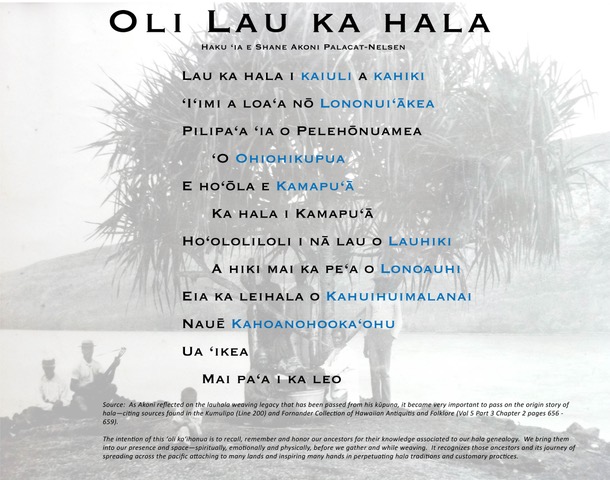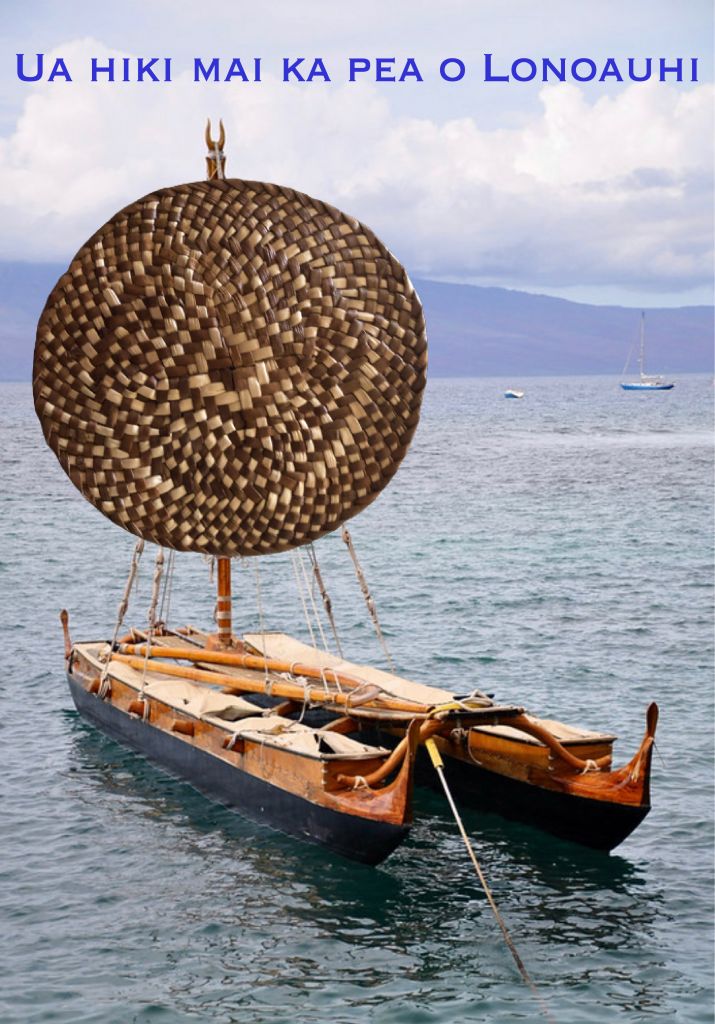Moʻolelo Monday
On the first Monday of the month a traditional or modern moʻolelo depicting the culture, values, language or traditions of Hawaiʻi, will be shared through a virtual platform. These mo‘olelo promote literacy within the classroom and home, and encourage ʻohana to read and learn together. Moʻolelo are shared by staff and guest storytellers.
MOʻOKALALEO
In the 1820’s, Kauikeaouli, Kamehameha III was the catalyst for the rise of literacy in Hawaiʻi. He stated, “ ʻO Koʻu Aupuni, he Aupuni palapala koʻu. My kingdom shall be a kingdom of literacy”. Within our moʻokalaleo, we share a literacy component that extends our moʻolelo journey.

Ohiohikupua is the name of the hala tree.
Its origins are said to belong to the Kanaloa clan, initially sprouting during the time of Pō in the kaiuli, or the depths of the ocean in Tahiti. It grew broad and vast under the sea and reached for the surface during the time of Ao. One day, the tip of the hala tree peered through the ilikai – the skin of the oceanʻs surface, entering into the atmospheric realm of Lononuiʻākea. Hala started popping up all over Kahiki.
According to one of many moʻolelo, the first hala plant arrives in Hawaiʻi on the canoe of Peleʻs travel from Polapola. When arriving at Halahalanui, Kōhala on the island of Hawaiʻi, Pele was entangled by the roots of the hala. Her frustrations led to her furiously breaking the ule hala and flying them across the land, spreading it out all over. Kamapuaʻa, who follows Pele from Tahiti digs the earth giving a fresh foundation for hala to grow.
Peleʻs mother Haumea was the younger sibling to Lauhiki, who pulls the knowledge together to be the first womang to plait the lau of the hala. Her patterns and weaving are so well known, that a man named Lonoauhi asked her to make a sail for his canoe which was round like the sun. Lonoauhiʻs journeys took him throughout the pacific spreading the knowledge of Lauhikiʻs weaving and sail making technique.
Lauhiki taught all the women, who were Godesses, to weave including her sister Haumea and their daughters named Ka-meha-i-kaua, Mea-hani-pāoa, Lohea, Ka-huihui-ma–lanai and Ka-hoa-noho-o-ka-ʻohu.
Kahuihuimalanai and Kahoanohookaʻohu were the first to take the drupes from the hua hala and string the first lei hala, a custom and tradition that is continued to this day. Ka-hoa-noho-o-ka-ʻohu was the name of Kamehamhea Nuiʻs sail for his waʻa peleleu.
It is important for us to remember and continue to spread the origins of hala, and its ʻike throughout the generation as we ʻaʻapo or grasp its knowledge while tilling through the various patterns and techniques – just as Kamapuaʻa did by creating a foundation for hala to grow.
Alternate Moʻolelo of Hala coming to Hawaiʻi
In the Hawaiian creation change Kumulipo, the pahaha or young mullet in the sea was born. The aerial roots, or ule hala provided protection for the pahaha from large predators. Young mullet would spawn in the tidal pools, the kaheka or fishponds called lokoʻia. Hala trees can be found growing on the edges of the kaheka or fish ponds. However, if compeletely submerged in salt water, the hala will not survive.
When Pele was traveling to Hawaii escaping Namakaokahai’s wrath, she was slowed and entangled in the hala. Her relative Pa‘ao was travelling the great sea at the same time, and notice Pele struggling. He went over and grabbed a pail of salt water and poured the water from the top of the tree, the leaves wilted away and the hala weakened loosening Pele from her bondage.
The first Pūhala: another moʻolelo version
Peleʻs brother, Kamohoaliʻi, is said to have planted the first hala tree in the Hawaiian islands. He brought the hala fruit cluster (ʻāhui hala) on the canoe from Kahiki in case the Pele family needed the fruit for food. When they were hungry, they ate the soft, inner ends of the fuit keys (pua hala). The also saved the hard ends of the hala keys (iwi hala) for planting.
When the Pele clan arrived on the island of Hawaiʻi, Kamohoaliʻi planted the hala seeds in Puna. A magical pūhala sprouted which was always laden with fruit. The tree was named Manuʻukeʻeu. From the fruit of this tree came the seeds that were planted and grown on every island in Hawaiʻi.


‘O ‘Ohi‘ohikupua ka inoa o ke kumu pū hala.
Aia ia ka ‘ohana Kanaloa, e kupu a‘e i ka wā pō i ke kaiuli ma ka moana hohonu o Tahiti. Ua nui a laha ia ma lalo o ke kai a puka a‘e i ka wā ao. I kekahi lā, ua puka mai ka wēlau o ke kumu pū hala i ka ‘ilikai, e komo pū ana nō ho‘i i ke ao o Lononui‘ākea. Ua ulu a‘e nā hala he nui a laha i Kahiki.
Ma loko o kekahi mo‘olelo, ua hō‘ea ‘ia mai ke kumu pū hala i Hawai‘i ma ka wa‘a o Pele, ‘oiai ‘o ia e huaka‘i ai mai Polapola mai. I ka pae ‘ana o Pele mā ma Halahalanui, Kōhala, ma ka mokupuni ‘o Hawai‘i, hihi maila ‘o Pele e nā ‘ule o ke kumu pū hala. Hele ‘o ia a huhū a haki ‘ia mai nā ule o nā hala e Pele a ho‘olele ‘ia ma ka ‘āina, e ho‘olaha ‘ia ‘āina i ‘ō i ‘ane‘i. Ua hahai ‘o Kamapua‘a iā Pele mai Tahiti mai a ‘eli ‘o ia i ka honua, a lilo ka ‘āina i kahua maika‘i no ka hala.
‘O Haumea ka makuahine o Pele a me ke kaikaina o Lauhiki, ‘o ia ka wahine mua e ulana i nā lau o ke kumu pū hala. Kaulana nō kona maiau o ke ulana ‘ana i ka lau hala, no laila, ua ninau akula ‘o Lonoahi iā ia e ulana i ka pe‘a no kona wa‘a i like ai me ka poepoe o ka lā. Ua holo akula ‘o Lonoauhi i ka laulā o ka Pakipika, e ha‘i aku ana i ka ‘ike o ko Lauhiki ulana ‘ana a me ka ulana ‘ana i ka pe‘a.
Ua ‘ao ‘ia nā wahine a pau, he mau akua wahine lākou, i ke ulana lauhala ‘ana e Lauhiki me kona kaikaina ‘o Haumea a me kāna mau kaikamahine ‘o Kamehaikaua, Meahanipāoa, Lohea, Kahuihuimalanai, a me Kahoanohooka‘ohu.
‘O Kahuihuimalanai a me Kahoanaho‘oka‘ahu nā wahine mua e kui i ka lei hala mai nā ‘āhui hala, he wahi loina e mau nei i kēia lā. ‘O Kahoanohooka‘ohu ka inoa o kā Kamehamehanui pe‘a no kona wa‘a peleleu.
He mea nui kākou e ho‘omana‘o i ke kinohi o ka hala a me ka ‘ike no kēlā hanauna kēia hanauna i mea a kākou e ‘a‘apo kūpono ai i ka ‘ike, nā ‘ano o ka ulana lauhala, e like me ka hana a Kamapua‘a i hana ai, e ho‘okahua ‘ia ana ka ‘āina no ka hō‘ulu ‘ana i ka hala.
Eia mai kekahi mo‘olelo ‘ē a‘e no ka hiki ‘ia ‘ana mai o ke kumu pū hala i Hawai‘i.
Ma loko o ke oli kumuhonua ‘o Kumulipo, ua hānau ‘ia mai ka pahaha i ke kai. Ua pale ka i‘a pahaha i nā ule hala mai nā i‘a nui. Aia nā pua i‘a ma ke kaheka a me nā loko i‘a. A, e ulu a‘e ana nā hala ma ka lihi o ke kaheka a i ‘ole ka loko i‘a. Akā na‘e, inā e ho‘olu‘u ‘ia ka hala i ke kai, o make ‘auane‘i ka hala.
I ka holo ‘ana o Pele i Hawai‘i me ka pakele pū ‘ana nō ho‘i iā Nāmakaokaha‘i, ua ho‘ohihi ‘o ia i ka ‘ule o ka hala. Ua holo like nō ho‘i ‘o Pa‘ao, he ‘ohana o Pele, ma ke kai ma ka manawa like a ‘ike akula ‘o ia iā Pele. Ua hele ‘o ia iā Pele a ki‘i ‘o ia i ka pele i piha ‘ia me ke kai a ho‘onini ‘o ia ma luna o ke kumu pū hala, o make ‘auane‘i ka hala, mae nā lau hala a nāwaliwali nō ho‘i nā ule o ka hala.
Ke Kumu Pūhala mua: He wahi mo‘olelo
‘O Kamohoali‘i, ‘o ia ke kaikūnane o Pele, ua kanu mua ‘o ia i ke kumu pū hala mua ma ka pae ‘āina ‘o Hawai‘i. Ua lawe mai ‘o ia i ka ‘āhui hala ma ka wa‘a mai Kahiki mai no ka mea, he wahi mea ‘ai no kona ‘ohana. Inā pololi lākou, ua ‘ai lākou i ka milu o nā pua hala. Ua mālama pū lākou i nā iwi hala no ke kanu ‘ana.
I ka hiki ‘ana mai o ka ‘ohana Pele i ka mokupuni ‘o Hawai‘i, na Kamohoali‘i i kanu nā hua hala i Puna. Ua ulu a‘e i kekahi pūhala kupaianaha me nā ‘āhui hala he nui. ‘O Manu‘uke‘eu ka inoa o kēia pū hala. Mai ka hua o kēia pū hala, ua kanu a ulu a‘e ka hala ma kēlā me kēia mokupuni o Hawai‘i.

Moʻo ʻŌlelo
Weekly, a Mo‘o ‘Ōlelo, a succession of Hawaiian words or phrases will be shared. The mana‘o behind each word or phrase relates to the mo‘olelo being presented. This component will enhance cultural awareness and knowledge through Hawaiian language.
ʻōlelo Noeʻau #720:
He lauhala lana.
Floating pandanus Ieaves.
Said of people who drift from place to place; worthless vagabonds.





